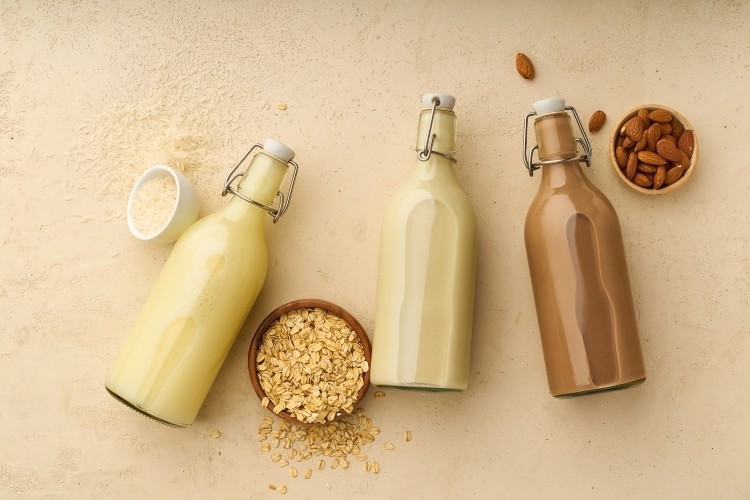New materials and technologies helping improve dairy alternatives

Which dairy alternative product categories have the most growth potential? What factors are motivating this growth?
Alternative dairy can be a gateway to a more flexitarian lifestyle, with non-dairy milk alternatives leading the pack. This category is more mature, and many options are available, including alternatives to milk made with soy, nuts and oats.
With advanced technologies and new raw material sources, formulators are solving for taste and texture challenges to create alternatives that more closely mimic traditional dairy. For example, dairy alternatives featuring enzyme-modified oat products are surging.
ADM research finds plant-based dairy alternative consumption is most prevalent at breakfast and between-meal snacks1. Additionally, 48% of regular dairy users enjoying a snack or light meal to start/end the day, either by themselves or with family, would be willing to replace their most recent dairy occasion in this situation with a plant-based option1. Brands can meet this need by improving the sensory experience of morning-friendly foods like alternatives to milks and creamers, yogurts and RTD smoothies.
Another area of growth is cheese alternatives for snacking occasions or main meals, and fermentation is an exciting, future-forward solution. Food scientists are building back dairy-like characteristics with products like dairy-free whey and dairy-free casein proteins from precision fermentation processes.
This is an evolution in the category of non-animal cheese currently dominated by plant-based varieties, which typically consist of a purposeful balance of starches, waters and fats that can mimic the texture of dairy cheese. With a fermentation-derived non-animal dairy protein, we’re starting to solve for the nutrition and performance factors of the equation.
Which applications are the most difficult to formulate alternative options for? How can industry innovations help?
Alternative dairy is a big business, and each segment requires a different strategy to achieve the final product, whether that’s non-dairy ice cream, milk, yogurt, butter or cheese.
Furthermore, alternative ingredients may pose challenges like off notes in taste and aroma or a gritty texture. Complementary ingredients can correct flavor and mouthfeel issues, ensuring plant-based options deliver a rich and creamy texture that may be lost with the absence of milkfat. Other potential concerns may be linked to production processes and parameters of specific applications.
For example, viscosity and color of beverages, or fermentation for making cheese, freeze-thaw capabilities of ice cream, and pH values or harsh processing conditions to formulate yogurt. A holistic, full-formula approach and technical ingenuity can solve these challenges and create delicious, consumer-preferred products.
Research finds 56% of global consumers are regularly purchasing comfort food because of COVID-192. Alternative dairy manufacturers can address this demand for more indulgent offerings by improving the sensory experience to increase enjoyment.
Many new product launches include coconut or blends such as coconut and oat or another plant-based alternative to develop creamier textures. Adding in rich dessert flavors like hazelnut fudge brownie or blood orange mimosa can enhance non-dairy yogurts, yogurt beverages, ice cream and frozen treats.
As more consumers seek permissible indulgences to satisfy cravings and boost mood, there’s heightened interest in low- or no-sugar offerings, flavors and colors derived from nature, as well as a nutrient profile similar to that of standard dairy. In fact, 57% of plant-based consumers would like to see more high-protein plant-based dairy alternatives3.
Product developers can satisfy these consumer demands by incorporating soluble protein from sources like pea, soy, hemp and sunflower. For example, our soy and pea proteins have a superior clean taste that reduces the need for flavor modifiers, and they’re high-quality proteins with PDCAAS (protein digestibility-corrected amino acid scores) of 0.8 or higher. Plus, we recently launched plant-based texture solutions that support clean labels for dairy-based and alternatives to ice creams, frozen desserts, spoonable yogurts and yogurt beverages. Plant proteins combined with natural flavors, colors and sweeteners help brands develop a recipe for success.
What’s next for dairy alternatives? What do you see as the next big trend?
One trend that’s already here and sure to gain prominence as a key differentiator is sustainability. New ingredients and formats will likely emerge and challenge existing plant-based offerings as potentially more ecofriendly alternatives.
We see kids’ nutrition as the next horizon, as the flexitarian lifestyle becomes a choice for families, not just individuals. Formulations, flavors and colors that appeal to children and their caregivers have a lot of potential.
For example, a non-dairy beverage that blends fruits, grains, nuts and/or spices can improve nutrition and flavor. Nutritional profiles of plant-based products are a growing concern among consumers, and we’ll likely see new entrants that can help fill nutritional gaps and increase nutrient density in alternative dairy products. Likewise, we also predict greater incorporation of ingredients with functional attributes, like support for digestive health, immune function or weight management.
These better-for-you oriented product enhancements will add value to dairy alternatives for parents and kids – provided they also deliver a truly enjoyable experience.
1ADM Outside Voice, October 2021
2FMCG Gurus, Top Ten Trends for 2021, January 2021
3Lightspeed/Mintel, March 2021









